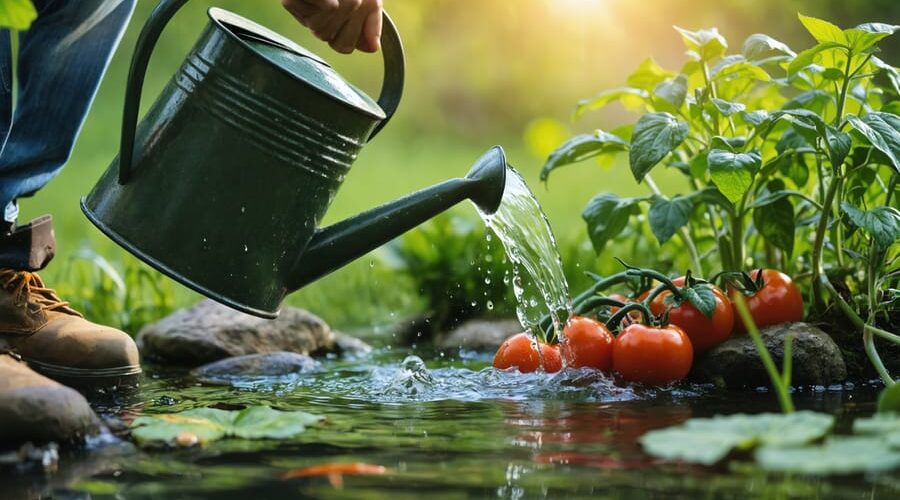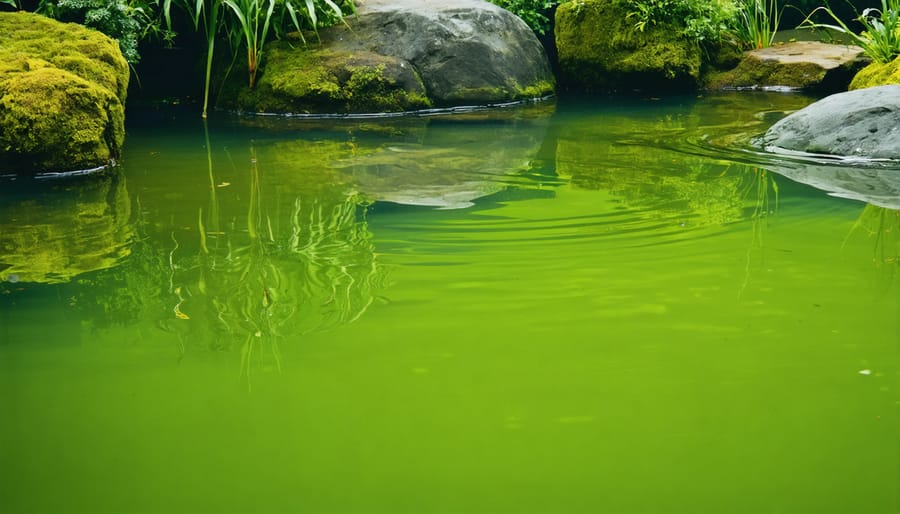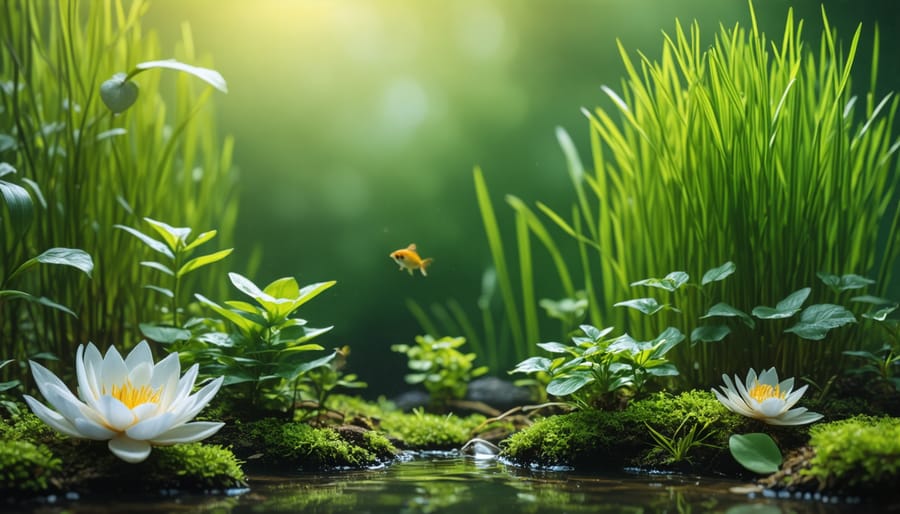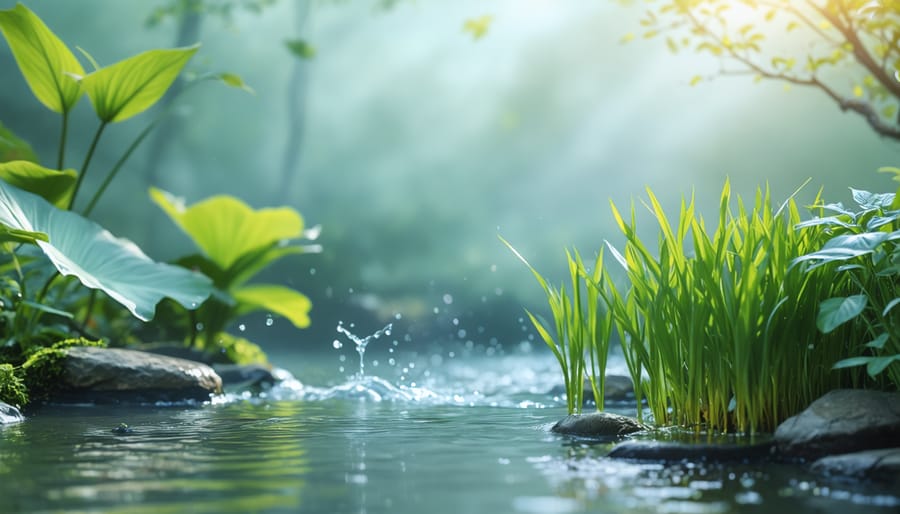
Turn Your Pond Waste Into Garden Gold (The Simple Formula That Works)
Your pond isn’t just beautiful—it’s a hidden fertilizer factory producing liquid gold for your garden. Every gallon of pond water contains measurable nutrients from fish waste, decomposing plant matter, and organic debris that your plants desperately want. The wastewater pounds formula (Pounds = Flow × Concentration × 8.34) transforms this murky mystery into precise calculations, showing you exactly how many pounds of nitrogen, phosphorus, and potassium your pond produces monthly.
Think of it this way: when you drain water during maintenance or backwash your filter, you’re literally pouring nutrients down the drain that could be feeding your tomatoes, roses, or lawn. One small backyard pond can generate 5-10 pounds of nitrogen annually—enough to fertilize a substantial garden bed without spending a cent on commercial products.
This formula isn’t just for scientists or commercial operations. It’s your key to understanding the nutrient wealth flowing through your pond ecosystem and harnessing it intelligently. By measuring your pond’s output and applying these nutrients strategically, you’ll discover one of the most overlooked sustainable gardening benefits hiding right in your backyard.
Whether you’re dealing with algae blooms, planning routine water changes, or simply curious about optimizing your pond-to-garden connection, this guide breaks down the formula into everyday language and gives you actionable steps to start harvesting your pond’s fertilizer potential today.
What Is the Wastewater Pounds Formula (And Why Your Garden Will Love It)
Here’s the thing that changed my pond-keeping game: I learned that the murky water I’d been tossing into the drain was actually liquid gold for my tomatoes. The wastewater pounds formula is simply a way to measure exactly how much plant food you’re sitting on.
Think of this formula as your nutrient calculator. It measures the weight of beneficial materials dissolved in your pond water—primarily nitrogen (the leafy-growth superstar), phosphorus (the root and bloom booster), and organic matter (nature’s slow-release fertilizer). When you clean your pond or skim off that greenish water, you’re collecting these nutrients in measurable quantities.
The basic formula looks at the volume of water you’ve collected, multiplied by the concentration of nutrients, which gives you the total “pounds” of usable plant food. Don’t worry—you won’t need a chemistry degree! Most pond enthusiasts use simple test kits (the same ones you’d use to check pond water quality) to get ballpark figures.
Here’s why this matters for your garden: A typical 1000-gallon pond cleaning might yield 2-5 pounds of nitrogen equivalent—that’s roughly what you’d buy in a decent-sized bag of synthetic fertilizer. But unlike store-bought options, pond nutrients come with beneficial microorganisms and organic compounds that improve soil structure.
For pond health, understanding these numbers helps you monitor nutrient buildup. If your calculations show high phosphorus levels, you know you’re overfeeding or have excessive organic debris—both situations that lead to algae blooms.
I started tracking my nutrient levels last spring, and my vegetable garden has never been more productive. My neighbor asked what miracle fertilizer I was using. “Pond scum,” I told her with a grin. She thought I was joking until she saw my zucchini.
The beauty is that by removing these nutrients through water changes, you’re simultaneously refreshing your pond while creating premium garden food. It’s the ultimate win-win scenario.

Understanding What’s Actually in Your Pond Water
Fish Waste: Nature’s Perfect Fertilizer
Here’s what makes your pond water so valuable: fish naturally produce waste that’s rich in ammonia, which breaks down into nitrates—essentially nitrogen in a form plants absolutely love! Think of it as liquid gold for your garden.
In a thriving pond ecosystem, fish constantly release ammonia through their gills and waste. Beneficial bacteria in your pond convert this ammonia into nitrites, then nitrates—the same nitrogen compound that gardeners pay good money for in commercial fertilizers. The beauty? Your fish are producing it 24/7, completely free!
Plants need nitrogen for healthy leaf growth and vibrant green colour. It’s one of the three essential nutrients (along with phosphorus and potassium) that every plant craves. When you use pond water on your vegetables, flowers, or lawn, you’re delivering these nutrients in a gentle, organic form that won’t burn plants like synthetic fertilizers can.
I’ve watched my tomatoes thrive on pond water while my neighbour’s struggled with store-bought fertilizer. The difference? Natural, balanced nutrition versus chemical alternatives.

Decomposing Plant Matter and Beneficial Bacteria
Your pond is essentially a nutrient factory working around the clock! When leaves drift into your water and settle at the bottom, they don’t just disappear—they begin an amazing transformation. These decomposing materials, along with dying algae and fish waste, break down into smaller particles that become dissolved nutrients.
Here’s where the real magic happens: beneficial bacteria are the unsung heroes of your pond ecosystem. These microscopic helpers colonize every surface—your rocks, filter media, and even plant roots—breaking down organic matter into forms plants can actually use. Think of them as tiny chefs preparing a gourmet meal from leftovers!
As these bacteria work, they convert complex proteins and carbohydrates into simpler compounds like nitrogen, phosphorus, and potassium—the same nutrients you’d find in commercial fertilizers. The difference? This process happens naturally, creating a perfectly balanced liquid fertilizer that’s gentle on your garden plants.
I’ve noticed that established ponds (those older than six months) produce the richest wastewater because their bacterial colonies are mature and working efficiently. The slightly murky water you sometimes see isn’t necessarily bad—it’s often teeming with these beneficial nutrients your garden will absolutely love!
The Nutrient Balance Sweet Spot
Your pond water becomes garden gold when nutrients hit that perfect balance—not too weak, not too strong, but just right. Think of it like Goldilocks testing porridge! The ideal concentration sits around 50-200 parts per million (ppm) of nitrogen, which typically comes from a well-established pond with fish and plants working together naturally.
Here’s the sweet spot: water that’s slightly greenish (showing some algae activity) but still clear enough to see a foot or two down usually contains perfect nutrient levels. Too clear means you’re missing out on natural fertilizer potential, while pea-soup green indicates it’s too concentrated and needs diluting before garden use.
I’ve found my best results using pond water that’s been sitting for at least two weeks after a water change—it’s had time to accumulate those beneficial nutrients from fish waste and decaying plant matter without being overly concentrated. When you dilute this at a 1:1 ratio with fresh water, you’re creating a gentle, slow-release fertilizer that won’t shock your plants.
How to Calculate Your Pond’s Waste-to-Resource Potential
Measuring Your Pond Volume (The Easy Way)
Here’s the good news: you don’t need to be a mathematician to figure out your pond’s volume! For rectangular ponds, simply multiply length × width × average depth in feet, then multiply by 7.48 to get gallons. For circular ponds, measure the diameter, divide by 2 to get the radius, then use: radius × radius × 3.14 × average depth × 7.48.
If your pond has an irregular shape like mine does, try the “bucket method”—it’s surprisingly accurate! When you first fill your pond, count how many five-gallon buckets it takes. Or, mark your water level, pump out a known amount (say, 100 gallons), measure how much the level dropped, then calculate from there.
Most pond owners find their volume is within 10-20% of their estimate, which is perfectly fine for the wastewater pounds formula calculations we’ll use later!
Estimating Fish Load and Waste Production
Understanding how much waste your fish produce is surprisingly straightforward once you know the basics. Here’s a simple approach that’s served me well over the years: as a general rule, fish produce waste equal to about 3-5% of their body weight daily. This includes both solid waste and dissolved nutrients through their gills.
Start by estimating your total fish biomass. For example, if you have ten goldfish averaging half a pound each, that’s five pounds of fish. Multiply that by 4% (a middle-ground estimate), and you’re looking at about 0.2 pounds of waste daily, or roughly 6 pounds monthly. Koi, being larger eaters, often fall toward the higher end of this range.
Don’t worry about being perfectly precise—this is gardening, not rocket science! The formula gives you a helpful baseline for understanding your pond’s nutrient potential. Keep in mind that feeding habits matter too. Fish consuming high-protein foods produce nitrogen-richer waste, while those on vegetable-based diets create slightly different nutrient profiles. During warmer months when fish are more active and eating heartily, expect waste production to increase accordingly.
Putting the Formula to Work: A Real Example
Let me walk you through a real-world example using my own backyard pond. Last spring, I wanted to calculate exactly how much nutrient-rich water I was pulling from my 500-gallon koi pond for my vegetable garden.
Here’s what I did: I filled my watering can three times, which totaled about 6 gallons of pond water. Using my basic pond test kit, I measured the nitrate level at 40 ppm (parts per million).
Now for the math—don’t worry, it’s easier than it looks! The formula is: **Pounds of waste = (Gallons × Nitrate ppm) ÷ 1,000,000**
Plugging in my numbers: (6 gallons × 40 ppm) ÷ 1,000,000 = 0.00024 pounds
Okay, that seems tiny, right? But here’s the thing—over a growing season, I collected pond water for my tomatoes about twice weekly. That’s roughly 100 watering sessions, giving me 0.024 pounds of nitrogen delivered directly to my plants. Combined with the other beneficial nutrients in that water—phosphorus, beneficial bacteria, and trace minerals—my tomatoes absolutely thrived!
The beauty of this formula isn’t necessarily the final number, but understanding that every gallon you use contains measurable nutrition. You’re literally turning pond maintenance into garden fuel, and now you can track exactly what you’re providing your plants.
Smart Ways to Harvest and Use Your Pond Water
The Best Collection Methods for Different Pond Sizes
Your pond size determines which collection method will work best for you. For **small ponds** (under 500 gallons), a simple bucket works perfectly. I started with a 5-gallon bucket and rope—just lower it in, scoop from mid-depth where nutrient concentration is highest, and you’re done in minutes. It’s free, requires no equipment, and gives you complete control.
**Medium ponds** (500-2,000 gallons) benefit from a basic sump pump setup. You can find affordable submersible pumps at any hardware store for around $30-50. Attach a garden hose, position the pump at your desired depth, and fill containers on shore. This saves your back and speeds up the process considerably.
For **large ponds** (over 2,000 gallons), consider investing in an automated system with a timer. These setups let you schedule regular water harvesting without being physically present. Some pond owners even connect their system directly to drip irrigation lines—talk about efficiency! The initial investment pays off when you’re managing significant volumes regularly. Whatever your pond size, start simple and upgrade only if needed.

When and How to Apply Pond Water to Your Garden
Timing matters! Apply pond water to your garden during the early morning or late afternoon—never during midday heat, which can shock plants and cause nutrients to evaporate before they’re absorbed. The growing season is prime time, especially during active growth phases when plants are hungriest for nutrients.
Here’s my tried-and-true approach: I use a simple 1:1 dilution ratio for most garden applications. Mix equal parts pond water with fresh water to avoid overwhelming plants with concentrated nutrients. For seedlings or sensitive plants, go with a 1:3 ratio (one part pond water to three parts fresh water). Container plants love a weekly feeding with diluted pond water, while established garden beds benefit from applications every two weeks.
Application techniques are straightforward. Use a watering can for precision around delicate plants, or connect a hose to pump pond water directly for larger areas. Always water at the soil level rather than overhead to prevent algae growth on leaves and maximize nutrient absorption at the roots.
I’ve found that vegetables, especially tomatoes and leafy greens, respond beautifully to pond water applications. Last summer, my tomato plants practically doubled their yield after regular pond water feedings! Just remember to rotate application areas to prevent any nutrient buildup in one spot.
One golden rule: never apply pond water if you’ve recently treated your pond with medications or chemical additives. Wait at least two weeks after any treatments before harvesting water for garden use.
Maximizing Your Waste-to-Resource Conversion
Balancing Fish Population for Optimal Waste Production
Finding the perfect fish population for your pond is like tuning a musical instrument—you want everything in harmony! Too few fish means you’re not producing enough natural nutrients for your garden. Too many fish, and you’ll overwhelm your pond’s ecosystem with excess waste, leading to murky water and unhealthy conditions.
Here’s my rule of thumb: aim for one inch of fish per square foot of pond surface area. For a 100-square-foot pond, that’s roughly 100 inches of fish total—perhaps ten 10-inch koi or twenty 5-inch goldfish. This sweet spot produces adequate waste for fertilizer collection while keeping your water clear and your fish thriving.
Watch for signs you’ve hit the balance: crystal-clear water with a slight green tinge, active and colorful fish, and healthy plant growth. If your water turns pea-soup green or fish gasp at the surface, you’ve tipped the scales too far!
Adding Plants That Boost Nutrient Cycling
Certain plants act like nature’s nutrient processors, turning pond waste into valuable fertilizer faster! Water hyacinth is a champion here—it absorbs nitrogen and phosphorus like a sponge, though you’ll need to manage its enthusiastic growth. Duckweed works similarly, covering your pond surface while pulling nutrients from the water column. Cattails and rushes planted around pond edges excel at filtering and concentrating nutrients in their root zones and leaves. I’ve found that incorporating these beneficial pond plants doesn’t just speed up nutrient cycling—they give you more plant material to compost for your garden beds! Water lilies and submerged plants like hornwort also contribute, though they’re slower nutrient accumulators. The key is creating a diverse plant community that works together to transform fish waste and decaying matter into harvestable resources.
Seasonal Adjustments for Year-Round Benefits
Your pond’s waste production changes dramatically with the seasons, so let’s adjust your harvesting strategy accordingly! During spring and summer, when fish are active and plants are growing vigorously, you’ll notice waste accumulation happens quickly—plan to harvest nutrient-rich water every two to three weeks. This is prime time for converting that “liquid gold” into garden fertilizer when your vegetables and flowers need it most.
As temperatures drop in fall, slow down your harvesting to once monthly. Your fish produce less waste in cooler water, and plants enter dormancy. I’ve learned this the hard way—over-harvesting in autumn can stress your pond’s delicate ecosystem balance just when it’s preparing for winter.
Winter requires minimal intervention in most climates. If your pond doesn’t freeze completely, one light harvest during mild spells keeps things balanced. Remember, you’re working *with* nature’s rhythms, not against them. Keep a simple calendar noting your harvest dates and observations—you’ll quickly develop an intuitive feel for your pond’s seasonal patterns and maximize year-round benefits without disrupting the natural cycle your aquatic friends depend on.
Common Mistakes That Waste Your Pond’s Potential
Over-Cleaning Your Pond (And Losing the Good Stuff)
Here’s the thing many pond owners don’t realize: you can actually be *too* clean! I learned this the hard way when I first started my water garden journey. I was so focused on crystal-clear water that I’d scrub everything down religiously, change out massive amounts of water, and basically strip my pond of all its character.
What I didn’t understand then was that pond water is liquid gold for your garden. All that “gunk” you’re removing? It’s packed with nitrogen, phosphorus, and potassium—the same nutrients you’d pay good money for at the garden center. When you over-clean, you’re literally pouring fertilizer down the drain.
Your pond naturally develops a balanced ecosystem where fish waste, decomposing plant matter, and beneficial bacteria create a nutrient-rich brew. By understanding the wastewater pounds formula, you’ll see exactly how valuable those nutrients are and think twice before that next excessive cleaning session. A little green tint isn’t your enemy—it’s garden treasure!
Using Water at the Wrong Concentration
Here’s the thing about pond water as fertilizer: concentration matters *a lot*. I learned this the hard way when I enthusiastically dumped straight pond water on my tomatoes, thinking more nutrients meant better growth. Wrong! Within days, those poor plants showed brown leaf edges—a classic sign of nutrient burn.
Undiluted pond water contains concentrated fish waste, excess nitrogen, and sometimes harmful ammonia levels. It’s essentially too rich for most plants, similar to giving them an overdose of fertilizer. Your calculations using the wastewater pounds formula tell you exactly how much nitrogen you’re working with, so use that information wisely.
On the flip side, over-diluting your pond water wastes its potential. If you’re mixing one cup of pond water into five gallons, you’re basically applying plain water with minimal benefit.
The sweet spot? Most garden plants thrive with pond water diluted at a 1:3 or 1:5 ratio (pond water to fresh water). For delicate seedlings or houseplants, go even lighter at 1:10. Think of it like making tea—you want it strong enough to be effective, but not so strong it’s overwhelming.
You’ve just unlocked one of nature’s best-kept secrets—turning what seems like waste into garden gold! By understanding and applying the wastewater pounds formula, you’re not just saving money on fertilizers; you’re becoming part of something bigger. You’re reducing chemical runoff, minimizing waste, and creating a genuine self-sustaining ecosystem right in your backyard.
The beauty of this approach? You don’t need to dive in all at once. Start with a single bucket during your next pond cleaning. Test it on a small garden bed. Watch what happens. I guarantee you’ll be amazed at how your plants respond to this nutrient-rich water that you once simply drained away.
Every gallon you redirect from the drain to your garden beds is a small victory for both your wallet and the environment. You’re closing the loop, creating something truly sustainable, and proving that the best solutions often come from working with nature rather than against it.
So grab that bucket, calculate those pounds, and transform your pond maintenance routine into an eco-friendly gardening advantage. Your plants—and the planet—will thank you!
